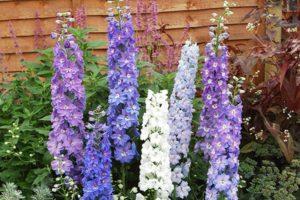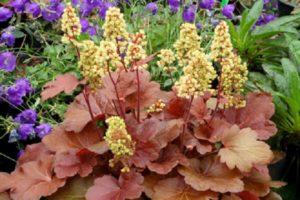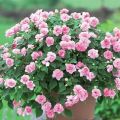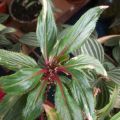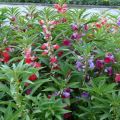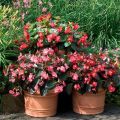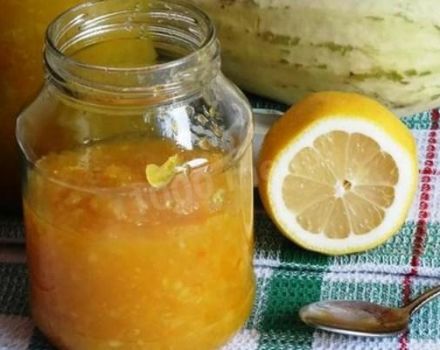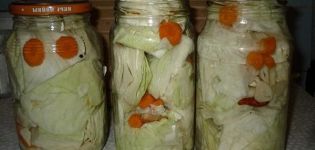Planting and growing New Guinea balsam, how to propagate and care
To grow New Guinea balsam at home, no special skills are required. The flower is a tropical plant cultivated as a potted crop, which is the result of a cross between flowering balsams and Hawker's balsam. Differs in compact size and is a decoration of any room.
Description and characteristics
Balsams are considered very popular with flower growers. This is primarily due to the ability to bloom almost all year round. The New Guinea species appeared relatively recently, but in a short period of time it has already managed to win the hearts of those who love beautiful indoor plants. Despite the fact that the plant has an exotic name, it feels great in our latitudes.
The flower is allowed to grow not only in pots, but also in personal plots, and in areas with a moderately warm climate, it is often planted in city flower beds.
Balsam Guinea has the shape of a bush with numerous smooth stems. The plant has a strong root system, thanks to which it grows well when provided with comfortable conditions. Leaves can be of various colors, from burgundy to dark green, and reach a maximum length within 13 cm. Their shape is oval or lanceolate, with serrated edging along the edges.
Beautiful, delicate flowers appear from the axils of the leaves, which are often painted in a pinkish or red shade with a pleasant double surface. Their size varies from 5 to 7 cm. There are varieties, the flowers of which are painted in salmon, apricot or fuchsia. They can be plain or two-color with patterns. At the end of the flowering period, seed pods appear in place of the buds. Among the variety of varieties of Guinean balsam stand out:
- Tall - from 50 cm to 1 meter.
- Low-growing - no more than 20 cm.
The stem of the Guinean balsam, in comparison with other varieties, is very thick, and the plant itself is distinguished by its power and fleshiness.
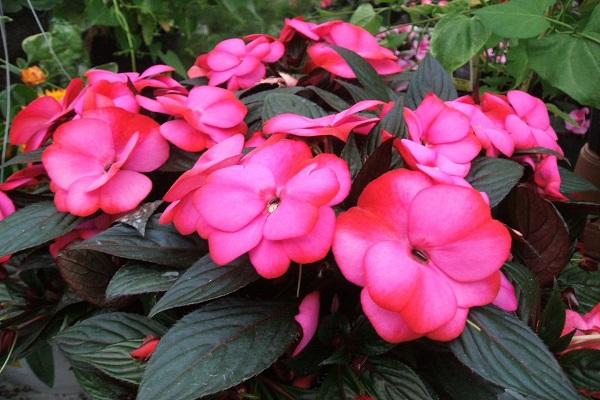
Main variety series
At the present time, many varieties and hybrids of Guinea balsam have been bred. The main difference in color is the height of the bush, color and shape. More often, these plants are distinguished not by individual varieties, but by whole series of varieties. The most common and recognized varieties are the following.
Macarena
A variety with a luminescent orange corolla and bronze-green leaves. This flower is very beautiful and unpretentious at the same time. With proper care, it will bloom throughout the year.
Jangle rain
A distinctive feature of this variety is the pale colors of the inflorescences, which are painted in pastel colors.
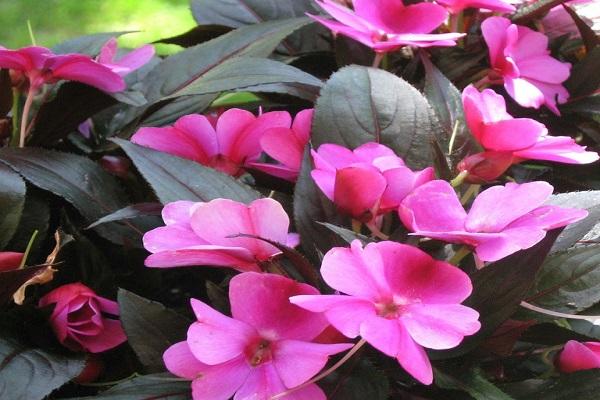
Hormony
The leaves of flowers of this variety have a bright red, bronze or green color. The flowers are almost round and dense. The bushes of the plant are densely branching and relatively compact.
Rainforest exotic
These balsams cannot but attract attention. A distinctive feature is the dark color of the leaves in combination with tropical monochromatic or two-tone shades.
Java
The series is distinguished by green or bronze leaves. The flowers of the plant are of a bright orange-pink-red hue.

Mini gini
Small-flowered series with dark bushes and densely covered flowers.
Divaro
The leaves of representatives of this variety have a bright green tint. The flowers are neat and medium in size.
Spreading White
A distinctive feature of the variety series are variegated leaves with snow-white flowers.
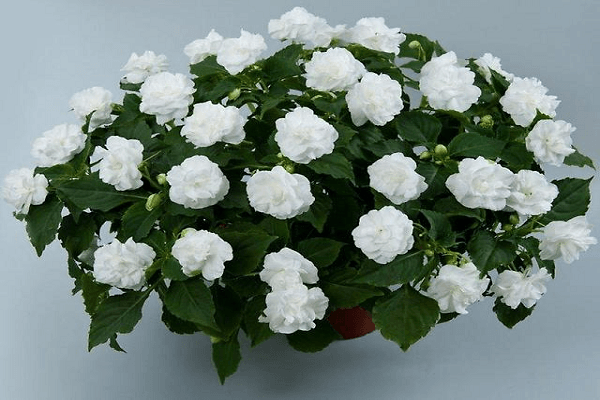
Devine
This is a new hybrid that has already gained popularity. Its main difference is its bright large flowers. The plant, in comparison with all other balsams, develops rapidly and has excellent immunity.
Growing conditions
You can grow Guinean balsam as an indoor or garden plant. Regardless, you can grow a flower from seeds that are sown in small boxes. Before planting, it is necessary to carefully prepare the soil, it must be fertile and easily breathable.
It is recommended to sow seeds in February, then in spring young plants will already be obtained. Planting seedlings in separate pots is carried out when several true leaves are formed.
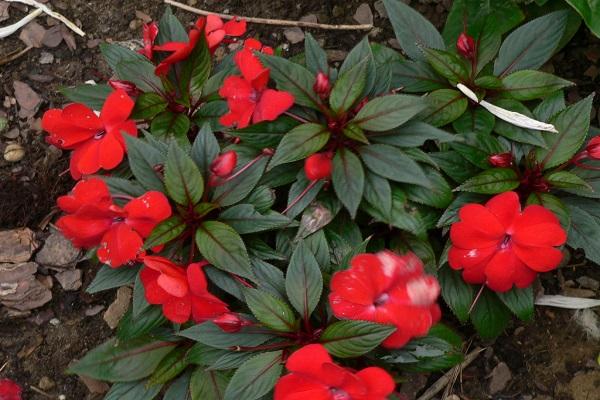
Lighting
Almost all balsams are light-loving plants. Places with soft diffused light are considered the most optimal placement. In winter, when daylight hours are reduced, you need to provide the plant with artificial lighting. Otherwise, the flower will lose its decorative effect.
Temperature
When growing a flower in indoor conditions, you can easily provide it with the most comfortable growing conditions. The optimal temperature regime is considered to be from 18 to 24 degrees. Temperature changes negatively affect the plant, and a decrease in indicators to -10 degrees and drafts can lead to its death. That is why it is not recommended to place a flower on windows that are often opened for ventilation.
Ventilation
It is recommended to grow Guinean balsam in pots with the obligatory presence of drainage holes, which will provide the plant with good ventilation.
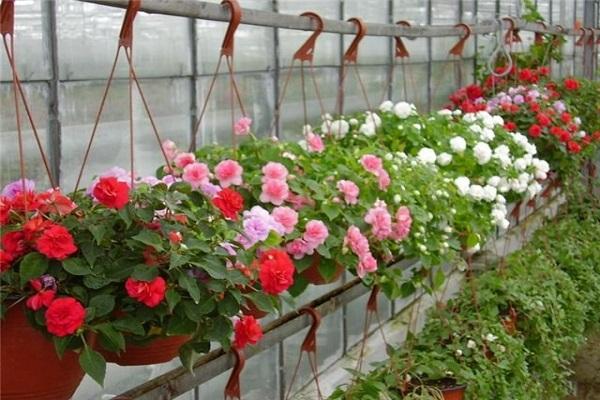
Humidity
In order for the plant to feel good, it is necessary to provide it with optimal air humidity, which should not exceed 60-70% and fall below 40%. In winter, it is recommended to spray the flower twice a day.
Water the flower sparingly, while remembering that it readily absorbs moisture. Avoid excess moisture and water ingress on the lower leaves to prevent rotting.
How to keep in winter
If suitable conditions are created for the plant, then it perfectly tolerates winter time. During this period, the flower should be provided with moderate watering, systematic spraying, additional lighting and a warm room temperature.
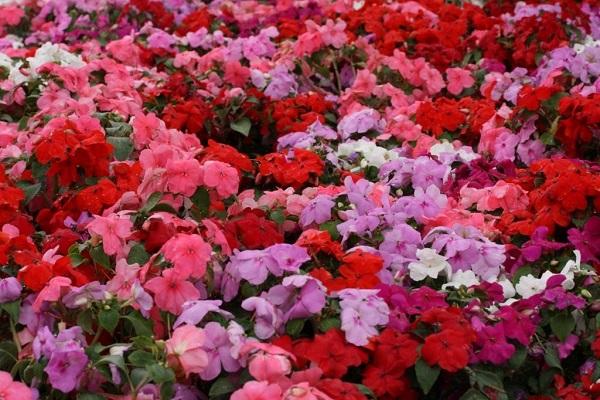
Transfer
It is recommended to transplant balsam once every 2-3 years. The most optimal time for this is spring. In this case, the following conditions must be met:
- For transplanting, you need to choose a pot that is small in depth and diameter. This will help ensure lush bloom.
- Expanded clay drainage should be placed at the bottom of the pot.
- After transplanting a flower, all the voids must be filled with nutrient soil so that the root collar rises several centimeters above the ground.
These simple conditions will ensure the rapid adaptation of the flower to new conditions and its rapid growth.

Diseases and pests
Since balsam lives in dampness, it is susceptible to rot and caused by fungal infections. To protect the plant from disease, it is recommended to apply fungicides at the first sign of damage. If the disease has already spread, then you can save the flower only by cutting off healthy stems and rooting them to get a new plant. Affected stems in such a situation are disposed of.
Balsam is notable for its juiciness, which is so loved by whiteflies, sciarids, aphids and thrips. To prevent their attack, you can regularly moisten the ground parts with insecticides.
Breeding methods
Guinea balsam multiplies in several ways. Both of them do not cause difficulties even for novice florists and are widely used in gardening.

Seed propagation
To propagate a flower in this way, you must:
- Prepare the soil mixture in advance.
- Gently place the seeds on top of the soil and sprinkle them a little on top.
- Moisten with a spray bottle or with a spray can.
- Cover the container with glass or plastic to create a greenhouse effect.
- Moisten and ventilate the soil regularly.
As soon as full leaves appear, the plant is planted in separate pots..
Vegetatively
You can propagate balsam by cuttings. To do this, follow these steps:
- choose young shoots and cut off several internodes from them;
- prepare the soil mixture;
- treat the cuttings with a stimulating solution;
- deepen the cuttings 2 centimeters into the ground;
- Using a cut plastic bottle, create a greenhouse over the seedlings.
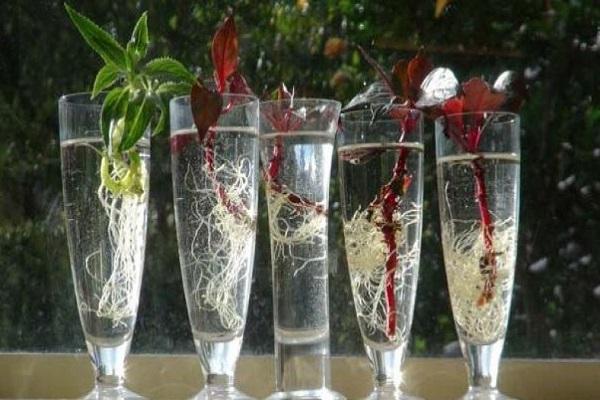
The planted seedlings must be constantly looked after. Monitor normal soil moisture and ventilate them daily. Reproduction by this method is best done in spring or early summer.
When propagating by cuttings, you need to pay attention to the age and type of the mother stem..
Preventive actions
With improper maintenance and care, a flower can not only be subject to diseases, but also acquire an unattractive appearance. To prevent this, flower growers recommend preventive measures.
The most effective way of prevention is considered to be careful plant care. You need to monitor the soil moisture, lighting, and also systematically carry out top dressing, the absence of which leads to the scarcity of flowering.
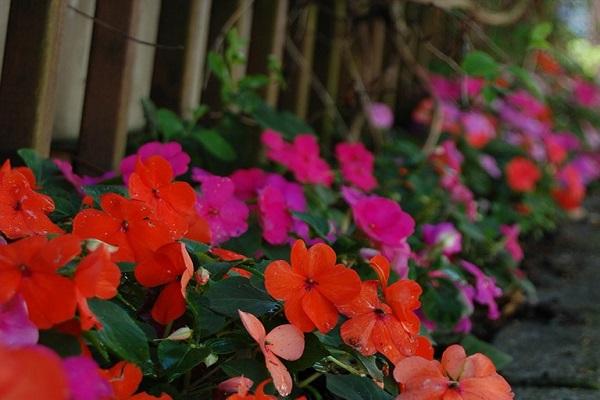
Main problems
As practice shows, more often diseases affect balsam as a result of improper care. Basically the following problems appear:
- leaves droop - this happens as a result of insufficient moisture and the presence of the plant at an elevated temperature;
- leaves fall off, turn yellow and dry - the plant is at a low temperature or receives a lot of moisture;
- flowers and buds fall - dry and hot air prevails in the room or the plant does not have enough light;
- leaves curl - the flower is damp and cold;
- weak flowering - feeding is not carried out or is carried out incorrectly;
- light spots appear on the leaves - the flower received sunburn, or was sprayed with hard water.
To make the plant look healthy and attractive, you need to care for it carefully and in a timely manner. Only in this case will the balsam delight others with an attractive view.
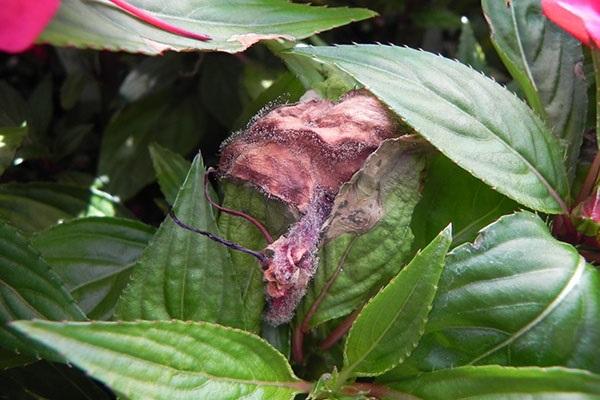
Reviews
Natalia, 37 years old, Novorossiysk: “I bought a blooming Guinean balsam in the garden center. There were already many buds on the plant when purchased. The seller recommended it as a flower that will bloom throughout the year.I have it for the third year already, it blooms beautifully and almost constantly. I try to take proper care of him so that the leaves do not wither, and he responds with gratitude. This flower became my pride, all my friends bought this variety for themselves. "
Anna, 56 years old, Moscow: “I am an amateur florist and I can’t walk past the shop windows with flowers, even when I’m not going to buy them. That time, I also stopped just to look at the flowers, and suddenly my attention was attracted by a beautiful blooming indoor balsam. Turning to the seller, I found out that this is Guinean balsam, she showed them three varieties, which differed in shades. I bought them all and have never regretted it. Surprisingly, this plant turned out to be completely unpretentious in the growing process. The only thing he needs is systematic watering. The flower is very colorful, bright and beautiful, blooms almost all year round. I recommend flower growers to add this plant to their collection. "
